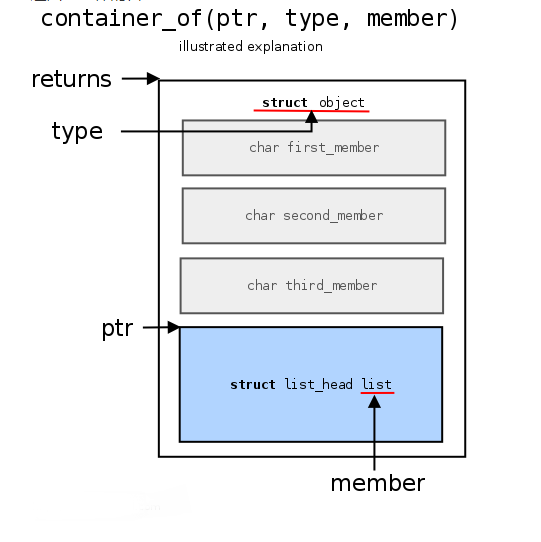1、前面说的
我在好几年前读linux 驱动代码的时候看到这个宏,百度了好久,知道怎么用了,但是对实现过程和原理还是一知半解。
container_of宏 在linux内核代码里面使用次数非常非常多,对于喜欢linux编程的同学来说,了解其实现方法,对以后看内核代码,写内核驱动的帮助都非常大,当然,我不是说了解这个就可以为所欲为了,内核博大精深,先宏观再微观去学习,不积跬步何以致千里,不要想着一口就能吃成一个胖子,我这篇文章主要剖析一下这个函数的实现原理,希望对大家学习过程中有所帮助。
android7.1/kernel/drivers/input kernel/drivers/input$ grep -rn container_of ./|wc -l 710 android7.1/kernel/drivers/input$
使用grep -rn container_of ./|wc -l统计了下kernel/drivers/input/目录下的container_of出现的次数,一共有710次使用。
2、container_of的作用
container_of的作用的通过结构体成员变量地址获取这个结构体的地址,假设你的名字叫李光明,你还有一个弟弟叫做XXX,警察叔叔发现你弟弟XXX干了一件坏事,但是警察叔叔不知道你弟弟的名字,抓你来审问,你嘴巴很硬就是不说,警察叔叔就拿到你的名字,查到了你家的户口本,这下你弟弟就被查出来了,原来你弟弟XXX的名字叫做李小明。这种破案手法叫做顺藤摸瓜。
内核函数调用常常给函数传入的是结构体成员地址,然后在函数里面又想使用这个结构体里面的其他成员变量,所以就引发了这样的问题,我认为这个也是用C实现面向对象编程的一种方法。
比如这段代码
static void sensor_suspend(struct early_suspend *h) { struct sensor_private_data *sensor = container_of(h, struct sensor_private_data, early_suspend); if (sensor->ops->suspend) sensor->ops->suspend(sensor->client); }
early_suspend是sensor_private_data 里面的一个成员,通过这个成员的地址获取sensor_private_data结构体变量的地址,从而调用里面的成员变量client。这个方法非常优雅。在这里我用到了一个比较叼的词,叫“优雅”。
这里简单说下,传进来的h一定在其他地方定义并且操作系统分配了内存空间,h分配了空间,说明他的老爸也有内存了,要不然你顺藤摸瓜摸到一个NULL就傻逼了。
3、如何使用container_of
container_of需要传入三个参数,第一个参数是一个指针,第二个参数是结构体类型,第三个是对应第二个参数里面的结构体里面的成员。
container_of(ptr, type, member)
- ptr:表示结构体中member的地址 h
- type:表示结构体类型 struct sensor_private_data
- member:表示结构体中的成员 early_suspend type里面一定要有这个成员,不能瞎搞啊
- 返回结构体的首地址

4、container_of 用到的知识点 剖析
4.1、({})的作用
({})、第一个先说这个表达式,很多人可能懂,可能在很多地方见到这个表达式,但是自己却没有注意,这个表达式返回最后一个表达式的值。比如x=({a;b;c;d;}),最终x的值应该是d。
代码例子:
#include<stdio.h> void main(void) { int a=({1;2;4;})+10; printf("%dn",a);//a=14 }
4.2、typeof获取变量的类型
这个我们很少看到,这个关键字是C语言关键字的拓展,返回变量的类型,具体可以看GCC里面的介绍
++Another way to refer to the type of an expression is with typeof. The syntax of using of this keyword looks like sizeof, but the construct acts semantically like a type name defined with typedef.++
代码例子:
void main(void) { int a = 6; typeof(a) b =9; printf("%d %dn",a,b); }
4.3、(struct st*)0的作用
尺子大家应该都用过吧,比如我想用尺子量一本书本的长度,我们第一时间就需要找到尺子的0刻度的位置,然后用这个0刻度的位置去对准书本的边,然后再贴合对齐,在书本的另一边查看尺子刻度就可以知道书本的长度了。
现在我们需要量一个结构体的长度,我们也可以用尺子来量,我们只要找到这个0刻度的位置就可以了。同理,即使我们不知道0刻度位置,我们首尾刻度相减一样可以计算出结构体的长度。
但是在C语言里什么事尺子呢?你想到的可能是sizeof,不幸的是,这个并不能满足我们的需要,所以才有了(struct st *),这个当作尺子真的再好不过了。
struct st{ int a; int b; }*p_st,n_st; void main(void) { printf("%pn",&((struct st*)0)->b); }
上面的代码
(struct st*)0
这个的意思就是把这个结构体放到0刻度上面开始量了,然后量到哪里呢?
&((struct st*)0)->b)
这个就体现出来了,量到b的位置。所以上面的输出应该是4。
看完上面的解释,应该知道下面这两个代码的功能是一样的。
typeof ((struct st*)0)->b) c; // 取b的类型来声明c int c;
其实不只是对于0,用其他数字一样是有效的,比如下面的代码,编译器关心的是类型,而不在乎这个数字。
printf("%pn",&((struct st*)4)->b -4 );
这文章写了有几天了,但是一直不想直接发出去,因为我觉得这个核心点总是没有找到一个特别好的论证方法,看完上面后,大概对这种测量应该有点感觉了吧,如果现在需要你把一个数组的首地址设置为0,要怎么做呢?
先思考一下,假设这里延迟了几分钟。
代码如下:
struct A { short array[100]; }; int main(int argc, char *argv[]) { int i = 10; A* a = (A*)0; printf("%p %d %dn",a,sizeof(short), &a->array[20]); getchar(); return 1; } //输出 00000000 2 40
有什么办法不使用==struct A *== 直接把数组的地址放到0位置呢?目前我还没有找到其他更好的办法,如果有好的建议的,请留言给我。
4.4、offsetof(TYPE, MEMBER)
#define offsetof(TYPE, MEMBER) ((size_t) &((TYPE*)0)->MEMBER)
size_t 这个有不懂的可以百度下,就是unsigned 的整数,在32位和64位下长度不同,所以这个offsetof就是获取结构体的偏移长度。
4.5、const int* p的作用
上面的宏定义里面还有一个小知识点
const typeof( ((type *)0)->member ) *__mptr
上面的代码可以简写成
const int * __mptr
这个说明什么问题呢?这个说明__mptr指向的整型数据是一个const(常数)。
这就涉及到两外两个知识
int * const __mptr;//表示__mptr的值不能改变 //和 const int * const __mptr; //表示__mptr不能改变而且指向的内容也不能改变
5、 container_of 剖析
看完上面的几个知识点,再来看container_of这个宏就显得非常清晰了。我把解析部分写在下面的代码注释里面。
#define offsetof(TYPE, MEMBER) ((size_t) &((TYPE*)0)->MEMBER) #define container_of(ptr, type, member) ({ const typeof( ((type *)0)->member ) *__mptr = (const typeof( ((type *)0)->member ) *)(ptr); (type *)( (char *)__mptr - offsetof(type,member) );}) //-----分割线 struct st{ int a; int b; }*pt; //用这个来举例 container_of(&pt->a,struct st,a) const typeof( ((struct st *)0)->a ) *__mptr = (const typeof( ((struct st *)0)->a ) *)(&pt->a); const int *__mptr = (int *)(&pt->a);//第一句解析完,实际上就是获取a的地址。 (type *)( (char *)__mptr - offsetof(type,member) ); //这个变成 (struct st *)( (char *)__mptr - ((unsigned int) &((struct st*)0)->a)); //这句的意思,把a的地址减去a对结构体的偏移地址长度,那就是结构体的地址位置了。
6、实例代码
经过上面的解释,至少对这个宏有感觉了吧,写个代码来测试一下,让自己与代码融合为一体,这样才能做到人码合一的境界。
代码如下:
#include<stdio.h> #include<stddef.h> #include<stdlib.h> #define offsetof(TYPE, MEMBER) ((size_t) &((TYPE*)0)->MEMBER) /*ptr 成员指针 * type 结构体 比如struct Stu * member 成员变量,跟指针对应 * */ #define container_of(ptr, type, member) ({ const typeof( ((type *)0)->member ) *__mptr = (const typeof( ((type *)0)->member ) *)(ptr); (type *)( (char *)__mptr - offsetof(type,member) );}) typedef struct Stu{ int age; char name[10]; int id; unsigned long phone_num; }*p_stu,str_stu; void print_all(void *p_str) { p_stu m1p_stu = NULL; m1p_stu = container_of(p_str,struct Stu,age); printf("age:%dn",m1p_stu->age); printf("name:%sn",m1p_stu->name); printf("id:%dn",m1p_stu->id); printf("phone_num:%dn",m1p_stu->phone_num); } void main(void) { p_stu m_stu = (p_stu)malloc(sizeof(str_stu)); m_stu->age = 25; m_stu->id = 1; m_stu->name[0]='w'; m_stu->name[1]='e'; m_stu->name[2]='i'; m_stu->name[3]='q'; m_stu->name[4]='i'; m_stu->name[5]='f'; m_stu->name[6]='a'; m_stu->name[7]='�'; m_stu->phone_num=13267; /*传结构体成员指针进去*/ print_all(&m_stu->age); printf("main endn"); if(m_stu!=NULL) free(m_stu); }
7、程序输出
age:25
name:weiqifa
id:1
phone_num:13267
main end
总结
以上就是这篇文章的全部内容了,希望本文的内容对大家的学习或者工作具有一定的参考学习价值,谢谢大家对脚本之家的支持。如果你想了解更多相关内容请查看下面相关链接













暂无评论内容